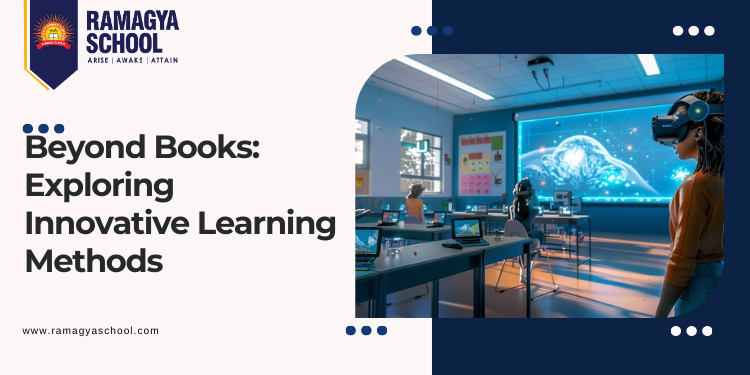Today’s world has so much more to offer than just study halls and assigned texts when it comes to education. Educators and educational institutions are using more and more innovative strategies to draw in pupils and improve their growth opportunities. This is being done in light of the diversity of learning preferences and our embracing of technological developments.
This shift prepares students for the difficulty of the cutting-edge world while sparking their creativity, critical thinking, and ingrained learning talents. We will look into a few of these cutting-edge, innovative learning methods or non-book learning techniques:
- Learning through projects (PBL):
- Project-Based Learning immerses students in real-world problems so they can explore and solve problems together.
- This complex process promotes critical thinking, creativity, and decisive reasoning.
- Students develop reasonable skills related to future careers and a deeper understanding of concepts by working on projects that are meaningful and applicable to their lives.
- Technology Integration:
- Integrating technology into education opens up new avenues for learning.
- From interactive simulations and virtual reality to educational apps and online platforms, technology enhances engagement and personalized learning experiences.
- It allows students to explore complex concepts visually, collaborate with peers globally, and access resources beyond the confines of traditional textbooks.
- Experiential Learning:
- The main focus of experiential learning is learning from first-hand experiences.
- Through field trips, internships, or outdoor activities, students engage directly with the subject matter in real-world contexts.
- This method fosters the development of skills, including teamwork, correspondence, and adaptability, while also supporting hypothetical information.
- Flipped Classroom:
- A Flipped Classroom concept shifts the traditional methods of instruction.
- Students use recordings or books to acquire basic material at home, while study hall time is devoted to active learning activities like discussions, activities, and critical thinking.
- This method stimulates more learning through dynamic commitment and accounts for individual learning speeds.
- Gamification:
- Gamification is the application of game-plan elements and standards in non-gaming contexts, such as education.
- Instructors can motivate students, increase engagement, and enhance learning outcomes by integrating game features such as targets, rival lists, and identifications into their learning exercises.
- Training becomes more natural, pleasant, and captivating when growth opportunities are gamified.
6. Interdisciplinary methods:
- Multidisciplinary learning integrates knowledge and skills from several fields to address complicated problems.
- They develop holistic understanding and multiple approaches.
- Students promote interdisciplinary reasoning, inventiveness, and development by bridging concepts from topics such as science, invention, designing, expressions, and math.
7. Customized Educational Journeys:
- Customized learning adapts educational experiences to the requirements, interests, and learning preferences of each student.
- Teachers can modify lesson plans, pace, and evaluations with flexible learning innovations and independent guidance.
- This method encourages students to take ownership of their education in order to gain more understanding and power.
How does Ramagya School embrace innovation in education?
Ramagya School is committed to fostering relationships and exciting growth possibilities by using innovative approaches to meet the various needs of its students.
- Project-Based Learning is one of the main approaches that Ramagya uses. Here, students engage in productive, hands-on activities that link classroom learning to real-world applications.
- At Ramagya School, innovation inclusion is just another training cornerstone. Students use state-of-the-art technology resources such as tablets, PCs, and user-friendly programming.
- Visitors’ talks, active exams, and field visits all effectively improve experiential learning. These interactions enable students to apply theoretical knowledge in real-world contexts, such as visiting art galleries to look into real antiques and rarities or performing logical exercises to understand standards.
In general, the dedication of Ramagya School to cutting-edge teaching techniques, including PBL, technology integration, experiential learning, and the Flipped. Ramagya School gives kids the skills they need to thrive academically and beyond by fostering creativity, critical thinking, and lifelong learning.
Embracing Innovation in Education
The adoption of these innovative learning methods requires a shift in educational paradigms and continuous professional development for educators. Schools and educational institutions play a pivotal role in creating supportive environments that foster experimentation, collaboration, and risk-taking in teaching practices.
As we look to the future of education, it’s clear that innovative learning methods not only supplement traditional teaching approaches but also enrich and transform educational experiences. By embracing diverse learning styles and leveraging technology, educators can empower students to thrive in a complex and interconnected world.
At the heart of it all is the commitment to nurturing lifelong learners who are adaptable, resilient, and equipped to contribute meaningfully to society. As we explore beyond books, let’s continue to innovate, inspire, and shape the future of education for generations to come.
Conclusion:
In conclusion, the journey beyond books is not just about exploring new methods but also about embracing a philosophy of continuous improvement and student-centered learning.
Together, let’s pave the way for a future where education is dynamic, inclusive, and transformative.





